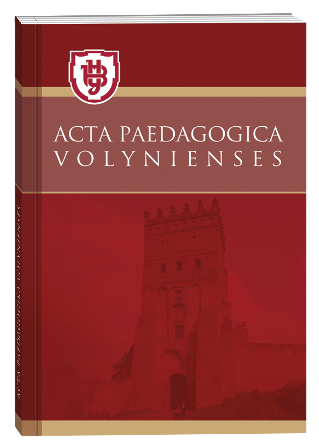PSYCHOLINGUISTIC MECHANISMS OF FORMATION OF SYLLABLE STRUCTURE OF WORDS IN PRESCHOOLCHILDREN WITH GENERAL SPEECH UNDERDEVELOPMENT
DOI:
https://doi.org/10.32782/apv/2025.1.24Keywords:
speech activity; preschool children; general speech underdevelopment; diagnostics; component structure of the word; formation methodAbstract
The article presents an analysis of the features of the formation of the component structure of words in preschool children with general speech underdevelopment. The complexity and stage-by-stage nature of this process, dependence on the current level of development of speech activity are indicated. It is noted that the psycholinguistic mechanisms of the formation of the component structure of words in the ontogenesis of the normal development of a child are due to the constant need to implement communicative intentions, occur in close interaction and interdependence. The identified mechanisms of violations are characterized; their interdependence is indicated. The main methodological principles and results of conducting a diagnostic study of the level of formation of the component structure of words in children with typical development and general speech underdevelopment are presented. The presented results indicate a low concentration of voluntary auditory attention, auditory memory, underdevelopment of phonemic representations, probable prediction at the component level of speech activity, insufficient volume of the active vocabulary of children, minimal communicative experience of using diverse words. All this is the reason for the lack of readiness of children to master the sound analysis and synthesis of words, the normative component structure of words, and may serve as a reason for such children to fall into the risk group for the occurrence of dyslexia and dysgraphia. The feasibility of developing and implementing into the correctional work system a methodology for the formation of the communicative component of speech activity of children with general speech underdevelopment is substantiated. The implementation of the main provisions of the methodology is planned and carried out in accordance with the key criteria and indicators of the formation of the communicative component of speech activity. In correctional work with children with general speech underdevelopment, the goal is to form a stable system of cognitive skills, speech knowledge, communicative experience, and improve the skills of applying operations of composite probabilistic prediction at the non-verbal and verbal levels.An important component of the work is expanding the range of communicative interaction, which includes the ability to analyze one’s own and others’ speech actions, and to transfer previously acquired communicative skills to similar situations.
References
Андрусишина, Л. Є. (2013). До питання про диференційну діагностику в логопсихології. Дефектологія. Особлива дитина: навчання і виховання, 4, 23–27.
Брушневська, І. М., Рібцун, Ю. В. (2023). Психолого-педагогічна підтримка дітей п’ятого року життя із лексико-граматичними труднощами : навчально-методичний посібник. Луцьк. 240 с.
Данілавічютє, Е. А., Трофименко, Л. І., Ільяна, В. М., Рібцун, Ю. В., Мартинюк, З. С. аnd Грибань, Г. В. (2022). Психолінгвістичні дидактичні технології діагностики і подолання мовленнєвих порушень у молодших школярів з тяжкими порушеннями мовлення : навчально-методичний посібник. Інститут спеціальної педагогіки і психології імені Миколи Ярмаченка НАПН України, м. Київ, Україна. ISBN 978-966-189-640-5.
Мартинчук, О. В. (2011). Активізація мовленнєвої діяльності дітей раннього віку в освітньому просторі дошкільного навчального закладу. Психолінгвістика, 8, 59–65.
Палій, А. А. (2010). Дитяча психодіагностика. К. : Академвидав, 432 с.
Рібцун, Ю. В. (2011). Корекційне навчання з розвитку мовлення дітей молодшого дошкільного віку із ЗНМ. К. : Освіта України, 294.
Соботович, Є. Ф. (2004). Психолінгвістична періодизація мовленнєвого розвитку дітей дошкільного віку. Теорія і практика сучасної логопедії, 1, 2–19.
Соботович, Є. Ф. (2002). Концепції стандарту спеціальної освіти дітей дошкільного віку з порушеннями мовленнєвого розвитку. Дефектологія, 1, 2–7.
Тищенко, В. В. (2013). Загальний недорозвиток мовлення: перспективи подальших досліджень. Збірник наукових праць Кам’янець-Подільського національного університету імені Івана Огієнка: Серія соціально-педагогічна, 2, 396–405.
Трофименко, Л. І. (2007). Корекційне навчання з розвитку мовлення дітей середнього дошкільного віку із ЗНМ: Програмно-методичний комплекс. Київ : Актуальна освіта, 120 с.
Forlin, C., Slee, R., Rouse, M., Garner, P., Rose, R. and Ashman, A. (2010). Education for inclusion: changing paradigms. Workshop presented to: Inclusive and Supportive Education Congress (ISEC): Promoting Diversity and Inclu- sive Practice, Queen’s University, Belfast.
Sharma,U., Loreman, T., & Forlin, C. (2012). Measuring teacher efficacy to implement inclusive practices: An international validation. Journal of Research in Special Educational Needs, 12(1), 12–21.







